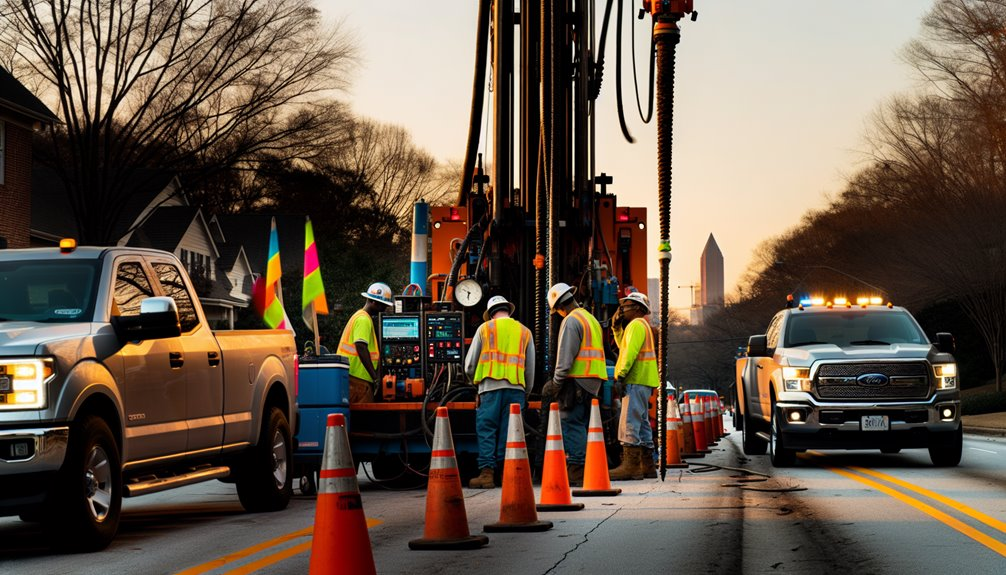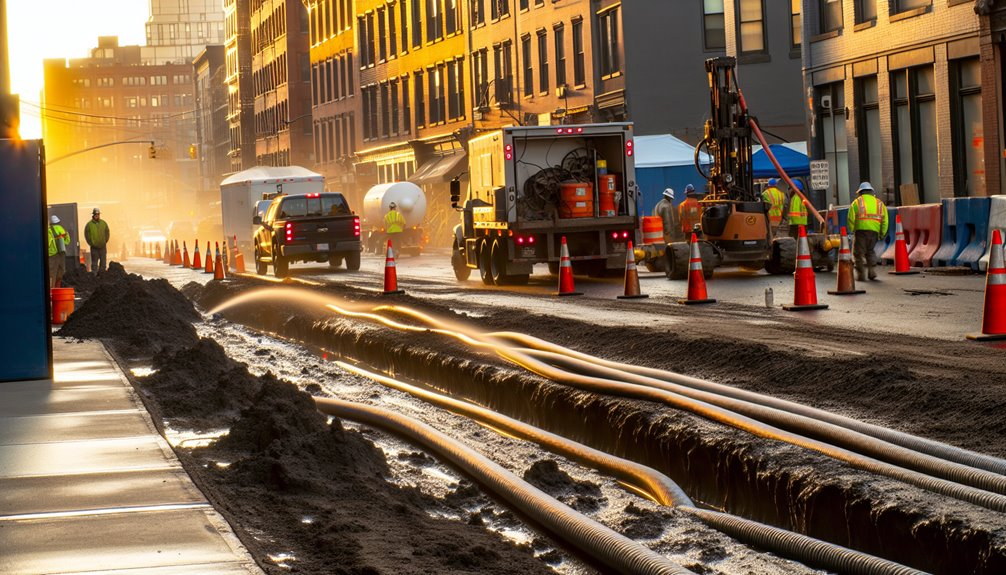If you’re hiring a directional drilling company in Atlanta, you need more than a low bid. You want a licensed, insured contractor proven in Piedmont granitic gneiss, clay-rich overburden, and fluctuating groundwater. They should navigate municipal permits, handle live utility ties, and run reliable HDD rigs with precise telemetry and locating. Ask for safety metrics, as-builts, and clear change-order controls. The difference between on-time success and costly strikes often comes down to what you verify next.
Understanding Atlanta’s Soil, Geology, and Urban Constraints
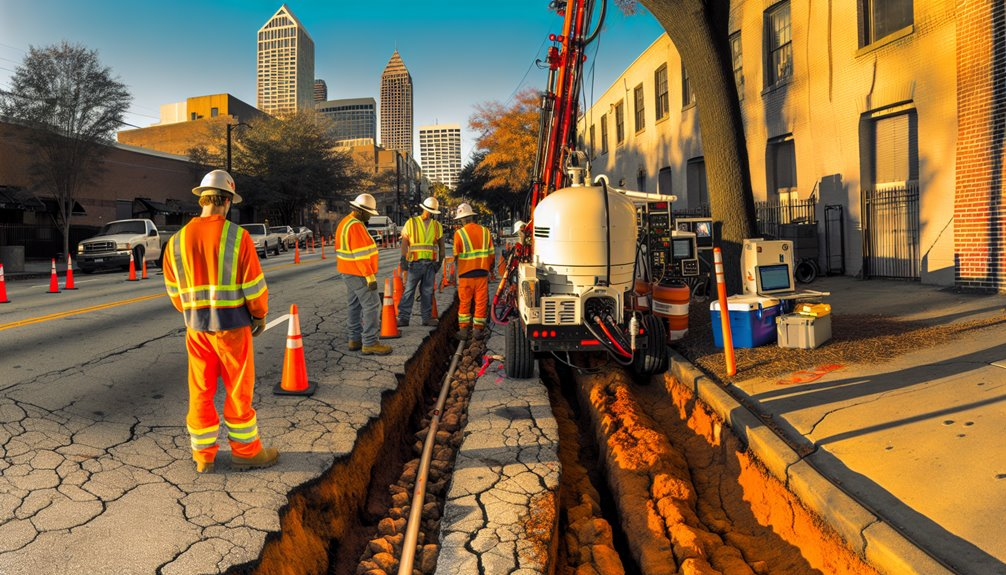
Before you hire a drill rig, know what you’re entering: Atlanta sits on the Piedmont, where dense granitic gneiss, saprolite, and variable red clay overburden create highly contrasting drilling conditions within short distances.
You’ll face Clay rich horizons that swell, lose strength when wet, and abrade tooling. Beneath, fractured bedrock zones can deflect bores, spike torque, and transmit vibration to nearby assets. Plan for Seasonal, groundwater fluctuations that change annular pressures, cuttings transport, and inadvertent returns risk.
Map utilities and roadway loads; narrow corridors limit entry angles and pipe bend radii. Calibrate mud rheology for mixed faces and temperature shifts. Specify pilot tracking with interference mitigation near rail, hospitals, and substations.
Sequence bores to minimize surface disruption, protect neighbors, and deliver predictable, documentable outcomes.
Verifying Licenses, Insurance, and Compliance Credentials
Although rigs and mud programs get the spotlight, you de‑risk the project first by validating the contractor’s paper.
Start with license verification: confirm active Georgia utility contractor licensing, bonded status, and any county endorsements.
Ask for certificate of insurance showing insurance limits that match your risk profile and name you as additional insured with primary, noncontributory wording and waiver of subrogation.
Require OSHA logs, EMR, and written safety program.
Verify compliance with 811, GDOT permits, and environmental requirements.
- Request originals: license verification, COI with current dates, endorsements, and insurance limits; cross‑check with the carrier, not the broker.
- Match scope to coverage: completed operations, auto, pollution, and professional where applicable.
- Set pass/fail thresholds and document exceptions before awarding.
Evaluating Experience With Utilities, Fiber, and Municipal Projects
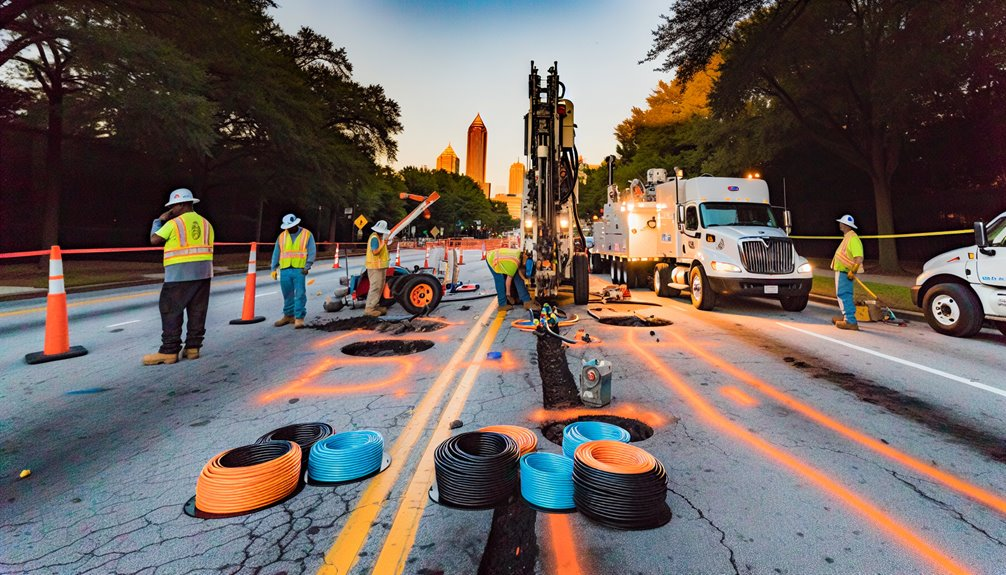
While insurance and licenses de-risk the paperwork, performance history de-risks the ground. Ask for project lists showing live ties with electric, gas, water, and telecom owners and how the team executed utility coordination under load and time constraints. Verify they’ve protected critical facilities, managed shutoffs, and documented as-builts that matched locates.
For fiber, confirm crews handle tight bend radii, conduit sizing, handhole placement, and post-bore fiber splicing standards that pass OTDR and loss budgets.
Probe municipal permitting experience in Atlanta and surrounding jurisdictions: lead times, plan review comments, right-of-way stipulations, and restoration specs. Require examples of traffic control, school-zone work windows, and ADA-compliant surfaces.
Finally, assess stakeholder care: door-to-door public notifications, outage windows, escalation trees, and after-action reports that prevent repeat hits.
Assessing Equipment, Technology, and Tracking Capabilities
Scrutinize the drill spread, locating systems, and data discipline because tool choice dictates risk and productivity.
Ask for rig horsepower, torque, and fluid capacity matched to Atlanta’s clays and cobbles.
Verify mud systems with solids control to protect returns and steering.
Demand locators and walkover tools that support real time tracking and sensor integration, plus wireline/Gyro options for congested corridors.
Insist on digital bore planning and as-builts tied to GIS so your team stays aligned.
- Confirm compatibility: drill head, reamers, and pipe designed for expected radii, pullback, and product pipe.
- Require telemetry: live annular pressure, downhole temp, and toolface to prevent inadvertent returns.
- Validate data discipline: pre-plan, track, and archive bores; share dashboards so stakeholders see progress and deviations immediately.
Safety Programs, Training, and Incident History
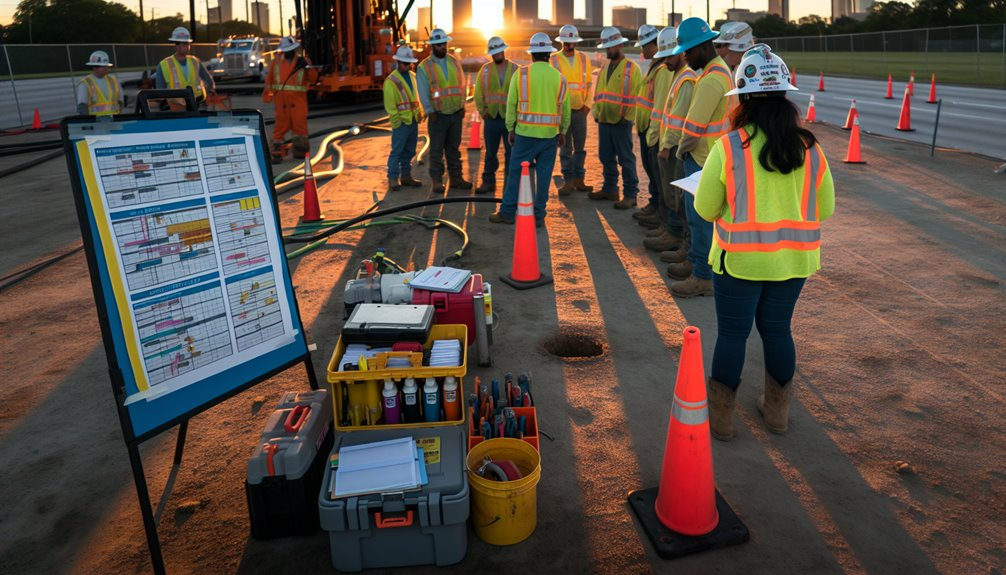
Your tooling and tracking only work if the crew runs a proven safety system that prevents incidents before they start. Ask for written programs: daily JSAs, lockout/tagout, utility-locate verification, confined-space protocols, and hot-work controls. Verify operator qualifications, refresher intervals, and third‑party certifications. You want a safety culture where foremen coach, stop‑work authority is honored, and near‑misses trigger corrective action.
Request three years of TRIR, DART, EMR, and recordable trends by scope and crew. Review incident reporting workflows: timelines, root‑cause methodology, and lessons learned distribution. Inspect audit results, corrective action closeout rates, and field observations. Confirm pre-bore hazard sweeps, strike-avoidance procedures, and vacuum excavation competency. Talk to references about behavior in the hole—communication, housekeeping, exclusion zones. When safety is lived, schedules hold and costs stay predictable.
Project Planning, Permitting Support, and Risk Mitigation
Because directional drilling rewards rigor, demand a contractor that front-loads planning, navigates permits, and engineers risk out of the work.
You want a partner that models subsurface conditions, validates utility locates, and aligns crews through disciplined timeline coordination.
In Atlanta, that means shepherding city, county, and GDOT permits, preparing traffic control plans, and sequencing work windows to protect neighbors and road users.
Expect proactive stakeholder communication with utilities, inspectors, and adjacent property owners so your project stays predictable and welcome.
Ask for a written risk register and mitigation plan covering tooling, frac-out response, and contingency bores. Require daily reporting tied to milestones and tolerances, not anecdotes.
1) Permit matrix with submission dates and dependencies
2) Drill path QC checkpoints and hold points
3) Escalation protocol and 24/7 contacts
Transparent Pricing, Change Orders, and Cost Control

Even before mobilization, insist on an itemized scope, unit rates, and measurable deliverables so pricing ties to production, not guesswork. Demand transparent estimates that break out labor, tooling, fluid, locates, traffic control, restoration, and contingency. Lock in change-order triggers: subsurface variance thresholds, utility conflicts, redesigns, and schedule impacts. Require written change-order forms that state scope deltas, revised quantities, time effects, and cumulative budget impact before work proceeds.
Control costs with daily quantity reports matched to unit rates, and perform invoice audits weekly to catch drift early. Use earned-value tracking: plan vs. actual footage, bores, and reinstatement. Cap markups for materials and subcontractors. Tie payment milestones to verified deliverables. Establish a dispute ladder and response times so decisions are fast, fair, and defensible.
References, Past Work, and Performance Guarantees
Before you award the work, demand verifiable proof of performance: recent HDD projects in Atlanta soils, client references with contact info, and metrics like bore lengths, diameters, tolerances, strike record, and schedule adherence. Ask for as-built records, frac-out logs, and restoration photos. Review client testimonials, but validate them with direct calls and site visits. You’re protecting your schedule, utilities, and reputation.
Insist on performance guarantees tied to measurable outcomes and clear warranty terms. Define remediation steps, response times, and liquidated damages if tolerances or schedules slip. Require the foreman who did the showcased work to lead your crew.
1) Specify bore path tolerances, annular pressure limits, and pullback forces.
2) Require documented drill fluid programs and contingency plans.
3) Tie payment milestones to passed inspections and utility clearances.
Conclusion
As the owner of Boring Bros., I’ve seen firsthand how the right checks—proper licensing and insurance, the right-sized HDD rigs and steering systems, solid mud and telemetry programs, clear scopes and unit pricing, and documented safety and utility-tie-in experience—turn risky projects into predictable ones. If you’d like to talk through a specific job or learn more about how we approach tough conditions like Piedmont gneiss and variable groundwater, please visit boringbro.com or give us a call at (954) 639-6167. I’d love to help you plan a compliant, on-schedule bore that performs.

